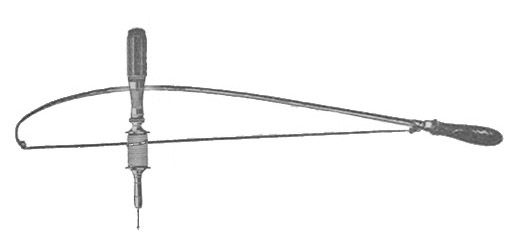CUTTING - NOT DRILLING - HOLES
 | ||||
home / about the artist / stoneboat series / lipwork series / metaphorical presences / landscapes / multi-element installation pieces / recent works
technical processes / thumbnail galleries / Cortona foundry / Finland stone carving / recommended reading / all in the family / links page
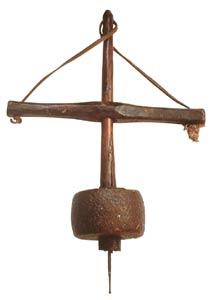
 | ||||
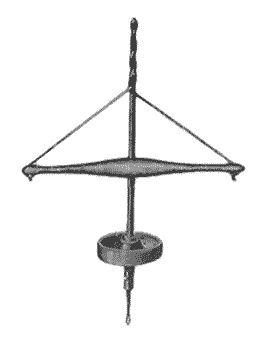
 | ||||
Given those basic premises, we can look at the processes and tools available to the sculptor and better understand the work itself. As a sculptor I perhaps have a greater affinity for stone than any other material, so I will begin with and concentrate upon those processes and tools.
The basic methods and tools for working stone by hand have remained unchanged for centuries, though a few technological achievements have dramatically altered the inherent potentials for the contemporary sculptor.
By understanding the basic processes the impact of those few improvements and additions to the sculptor's toolkit becomes easier to assess.
The Bow Drill was the type of boring tool which was traditionally used in stone carving studios to achieve delicate representations of locks of hair, lace fringes, narrow folds of drapery, etc.
Another great sculptor of the twentieth century, Isamu Noguchi, once said,
"The essence of sculpture is for me the perception of space, the continuum of our existence . . . Since our experiences of space are, however, limited to momentary segments of time, growth must be the core of our existence."
www.dondougan.com
DON DOUGAN
BORING TOOLS
Material, Tool and Process: essential design elements
 | ||||
A basic process for working stone is to bore a hole that either penetrates
through the stone or that creates a hole in the surface that leads the
viewer's eye into the interior of the form.
Boring holes of small diameter was commonly done with either of two
types of tool - the Pump Drill or the more sophisticated Bow Drill. Both
of these tools utilized the twisting action of a taut flexible cord to create a
spin of the drill bit in reciprocating directions within each stroke cycle.
 | ||||
Both the Pump Drill and the Bow Drill were ideal for boring delicate or thin areas in the carving.
Details of a portrait by Giuliano Finelli, a young sculptor who worked on this bust with Bernini in
1626, which shows the use of the drill to define the form of the hair and the lace collar.
sometimes the drill marks are left to create a accentuating shadow
the drill is penetrated to different depths
to suggest the thinness of the lace
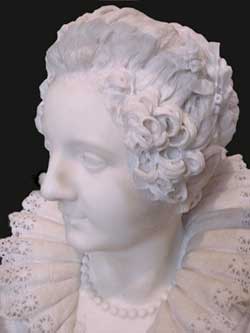
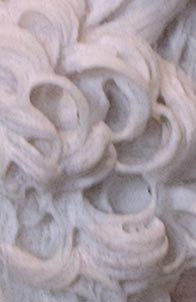
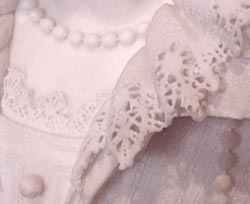
Maria Duglioli Barberini (1599-1621)
Giuliano Finelli (1602-1653)
collection Barberini
Louvre
TRADITIONAL PROCESSES
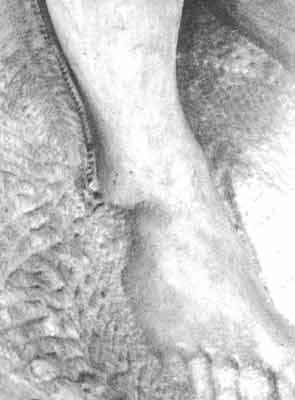
detail of unfinished 'Slave'
Michelangelo (1475-1564)
Academia, Firenze
note how the drill is used here to outline the form of the leg

detail of a carving of a man
Giovanni Pisano (1250-1314)
Victoria & Albert, London
here the drill is used to create the fringe of
the shawl
again, the drill is used to work
the curls in the hair

 | ||||
The
Carver's Hand Drill
is struck with a hammer and rotated slightly with each blow. In its simplest version this tool is almost indistinguishable in appearance from the Carver's Rondel Chisel, which also
has a single curved cutting edge.

 | ||||
An Auger Bit was used for boring larger diameter holes in stone, in use it would be fastened either in a simple cross-handle at the top (at left), or fitted into a brace (above).
often the drill marks are filed or abraded away to enhance the flowing lines of the form
The Pump Drill (above) and the
Bow Drill (at right)
are from the late nineteenth century,
though tools of these basic types
have been used for millennia.
The Pump Drill (at right)
is a craftsman-made example

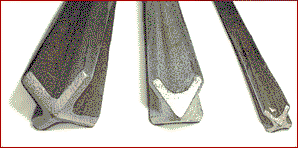
Later versions introduced an additional cutting edge or edges which gave rise to the name Star Drill.
Because of its percussive nature this type of drill is only suitable for use when there is a substantial mass of stone surrounding the area where the hole is to be created.
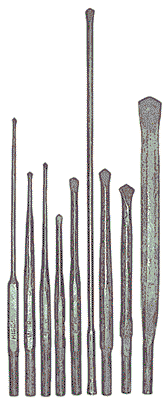
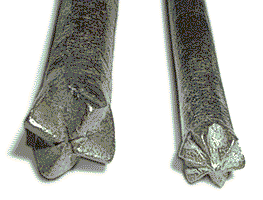
 | ||||
 | ||||
 | ||||
After Trow and Holden invented the air powered Carving Hammer over 100 years ago the pneumatic Carver's Drill (sometimes called a Plug Drill) followed . . .

Star Drills
have a typical criss-cross pattern on their cutting tips.
An assortment of Drills to fit into the
1/2" socket of a Pneumatic Hammer, ranging from 1/4" to 1" in diameter.
The standard length for a
Star Drill is
12" long.
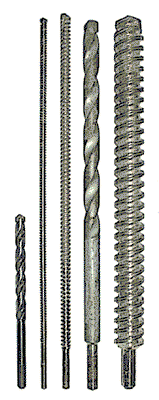
 | ||||
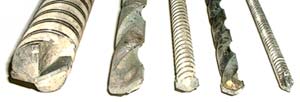
 | ||||
The portable electric drill and the introduction of inexpensive and long-lasting tungsten carbide tips has made the Rotary Masonry Twist Drill Bit the most common type of drill bit used for stone today.
Carbide-Tipped Masonry Twist Drill Bits
are available from 1/8" to 1" diameter, in the smaller diameters lengths are typically 4" long, while 1/4" and larger diameters are available in 6" and 13" lengths.
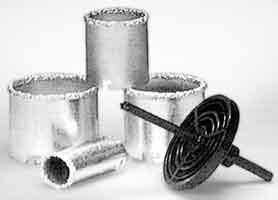
 | ||||
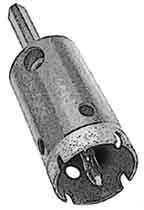
 | ||||
Diamond Core Drill Bit
Tungsten-Carbide Grit Holesaw Bits
Also available for electric and water-fed drills are a variety of hollow core bits or holesaws which have an abrasive grit (either diamond or tungsten carbide) embedded in the cutting edge.
Carbide-Tipped Glass Drill Bits are available from 1/8" to 5/8" diameter, and are usually no more than three or four inches overall in length.
 | ||||
NOT MADE FOR IT, BUT . . .
High-Speed Alloy Metal Twist Drill Bits are available in the widest range of sizes of any type of drill bit, but the cutting edges of even the heat-resistant cobalt and tungsten versions will 'burn' and become unusable if attempting to bore stone at common drill rpm's.
Solid tungsten-carbide versions or the addition of a precision-ground carbide tip is one solution for drilling precise fractional holes in stone, but these types of bit are both hard-to-find and rather expensive.
Though these type bits are made primarily for use in a simple rotating drill motor, when boring harder stones the drilling speed can be increased dramatically by using a drill that employs a 'hammer-action' in addition to the rotary motion.
During initial roughing-out stages of carving the use of a hammer drill is very efficient, however the trauma of the hammer-action on an already-carved piece of stone can end in 'pieces' rather than a hole.
For creating large diameter holes the holesaw is much more efficient and less traumatic to the workpiece than other types of drill bits made for stone and masonry.
Though made for drilling sheets of glass, these bits allow exceptionally clean and crisp through-holes in thin slabs of stone without spalling-out the exit hole on the back side of the material.
 | ||||
High Speed Alloy Twist Drill Bits
are made for boring of metal and general materials.
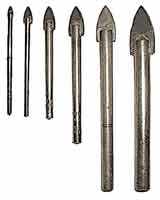
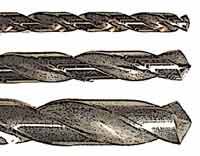
However, if the commonly available 'high speed alloy' bits are used at very low speeds (less than 50 rpm) and the hole is kept free of dust (compressed air or water-feed), they will provide crisp and precise holes in hard marble with no adverse effects to either bit or stone.
 | ||||||

When Constantin Brancusi said,
" . . . you cannot make what you want to make, but what the material permits you to make.
You cannot make out of marble what you would make out of wood, or out of wood what you
would make out of stone."
he is implying that the specific processes and tools we use as sculptors also compels us to create specific types of form. It follows that if we can then understand the potential allowed within those processes (and each accompanying tool within that process), then our conceptual vocabulary will also be expanded to its own greatest potential and thus extend our power to communicate.
As we extend ourselves through the processes and the tools we grow as individuals. As visual artists, personal growth is what makes us decide to paint a new canvas, carve a new stone, or cast a new bronze.
 | ||||||

Noguchi went on to write of the collaboration between the stone and the carver:
"Carving follows the possibilities inherent to the stone. This collaboration is limited, but the other way is confrontation. What is required is a certain irrationality which a promising stone inhibits. Confrontation may lead to conquest, conquest over oneself, of course, not the stone. Art is more this than compromise: to override the inhibitions that blind."
Another important sculptor who unfortunately died young, Eva Hesse, echoed this idea in a statement referring to materials and how they affected her working process:
"I'm not conscious of materials as a beautiful essence . . . I am interested in finding out through working on the piece some of the potential and not the preconceived . . . I want to allow myself to get involved in what is happening and what can happen and be completely free to let that go and change."
 | ||||||

However, the degree of difficulty that he overcame in his work is revealed through his own words. As he was in the finishing stages of working on Louis XIV's marble portrait bust, Bernini was quoted as saying,
". . . dared to tell His Majesty that it was no easy thing to attain that
lightness in the hair to which he aspired, for he had to struggle
against the contrary nature of the material."
quoted from
David Esterly's book Grinling Gibbons
and the Art of Carving, Harry N. Abrams:
New York, 1999
Gianlorenzo Bernini (1598-1680), perhaps the single most important artist of the Italian Baroque, is well known for his flowing, dynamic carvings in which the stone appears to have been worked in a plastic manner, seemingly without hindrance from the obdurate nature of the material. Much of this work was due to his virtuoso use of the drill, which allowed him to give the material an illusion of fluidity.
 | ||||

 | ||||
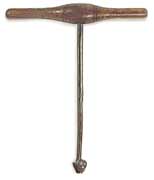
Auger Bits
for stone
